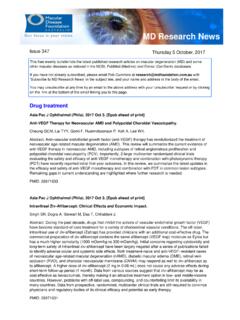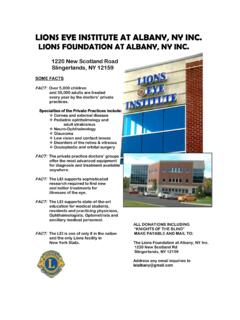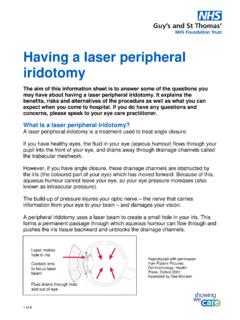Transcription of Myopic Macular Degeneration - Macular Disease …
1 Myopic Macular DegenerationMyopic Macular Degeneration can occur in people who are severely short-sighted due to extreme elongation of the eyeball. The stretching of the retina can result in tears in the macula and bleeding beneath the the eye works Light passes through the cornea at the front of your eye, and is focused by the lens onto your retina. The retina is a delicate tissue that lines the inside of your eye. The retina converts the light into electrical signals that travel along the optic nerve to your brain. The brain interprets these signals to see the world around from the object you are looking at directly is focused onto a tiny area of the retina called the macula at the back of the eye.
2 The macula is about 4mm across and is responsible for detailed central vision and most colour vision. It provides the vision you need to read, recognise faces, drive a car, see colours clearly, and any other activity that requires detailed, fine vision. The rest of the retina gives you side vision (peripheral vision). What is myopia?Myopia, often known as being short-sighted , causes vision to be blurry in the distance but clearer when looking at things up close. It is a very common condition of the eyes and, for most people, it can easily be dealt with using contact lenses or glasses which will make vision clear and crisp.
3 Most people have myopia because their eyeball has grown too long or their cornea (the clear window at the front of the eye) is more steeply curved than usual. These differences cause a problem with the way the eye is able to focus light. With myopia, the light coming into the eye from distant objects focuses in front of the retina which makes vision blurry. Moving closer to an object changes the focusing of the light and the object is then in focus on the retina and therefore looks clear. To correct for this blurring, optometrists can measure focusing power and prescribe corrective glasses or contact lenses.
4 The strength of the lens required to correct sight back to a normal level is measured in dioptres (D). This is normally written like dioptres (D) . On a glasses or contact lens prescription a minus sign is used to show that the lens corrects for myopia. The higher the number the more short sighted one would be. Mild myopia includes powers up to D Moderate myopia, values of to D High myopia is usually myopia over D Problems associated with high myopiaPeople with high myopia (more than dioptres) are at risk of pathological myopia where permanent degenerative changes can occur to the retina at the back of the eye.
5 These changes can cause a reduction in sight. The stretching of the retina in myopia causes the retina to become thinner which can lead to areas of retinal atrophy. When an optometrist or ophthalmologist looks into the eye, the areas of atrophy look very pale and blood vessels that are behind the retina can be seen. Vision at these areas may be reduced or even blanked out causing blind patches in the visual field. Retinal atrophy can occur anywhere on the retina and if it happens in the central macula area, it can affect central vision. At the edge of the retina there may be changes and thinning of the retina known as lattice Degeneration .
6 In many people lattice Degeneration causes no problems, but it should be regularly monitored by an eye specialist. The risk of retinal Degeneration increases with the presence of lattice Degeneration , which in turn increases with high myopia. Laser treatment or cryotherapy (localised freezing) may be needed to prevent a retinal detachment from developing. As the eye stretches it can cause breaks to appear in a special layer immediately between the retina and the choroid called Bruch s membrane. These breaks look like fine lines and are known as lacquer cracks. There isn t any treatment for lacquer cracks and they don t affect vision directly.
7 However they are the first signs of further problems which can develop and cause changes to vision. In some people new blood vessels can grow under the retina from the blood vessels in the choroid layer through lacquer cracks or areas of atrophy. This is known as choroidal neovascularisation (CNV). The new blood vessels are fragile with leaky walls and they ooze fluid and blood under the retina, leading to scarring and vision loss. If new blood vessels develop at the macula it is known as Myopic Macular Degeneration or Myopic maculopathy. At the macula, the scarring caused by the new blood vessels is called a Fuchs spot.
8 This is a circular area of pigment which develops after the new blood vessels and bleeding has gone. Myopic Macular Degeneration affects our detailed central vision making it difficult to read and see faces. Colour vision can also be affected. Treatment of myopiaMost people who have myopia may not have any complications and will only need glasses or contact lenses to make vision sharper. The higher the level of myopia, the greater the risk of additional damage occurring to the retina. If the retina has been damaged then vision may need more than glasses to help see better. There are no treatments available to stop the complications of high or pathological myopia.
9 This is because it is not possible to control the growth of the eye. Currently treatment is aimed at managing complications when they happen. People with Myopic Degeneration should be monitored regularly by the eye specialist. They should also self-monitor their vision daily using an Amsler grid (available free from the Foundation). Any sudden changes in vision or any new symptoms should be checked by the eye specialist as soon as possible. The type of treatment needed will depend upon the eye condition or the change that has developed. Not all the eye changes that happen in pathological myopia can be treated.
10 Treatment of Myopic Macular degenerationA protein called vascular endothelial growth factor (VEGF) is mainly responsible for the leaking and growth of the new, fragile blood vessels. To slow or stop their growth, a treatment with an anti-vascular endothelial growth factor (anti-VEGF) drug may be used. Anti-VEGF drugs are administered as injections into the eye by an ophthalmologist. The usual treatment regimen begins with monthly injections for three months. Then to maintain control of the Disease , injections are typically continued on an indefinite basis. The interval between these ongoing injections is determined on an individual basis by the eye specialist in consultation with the patient.









